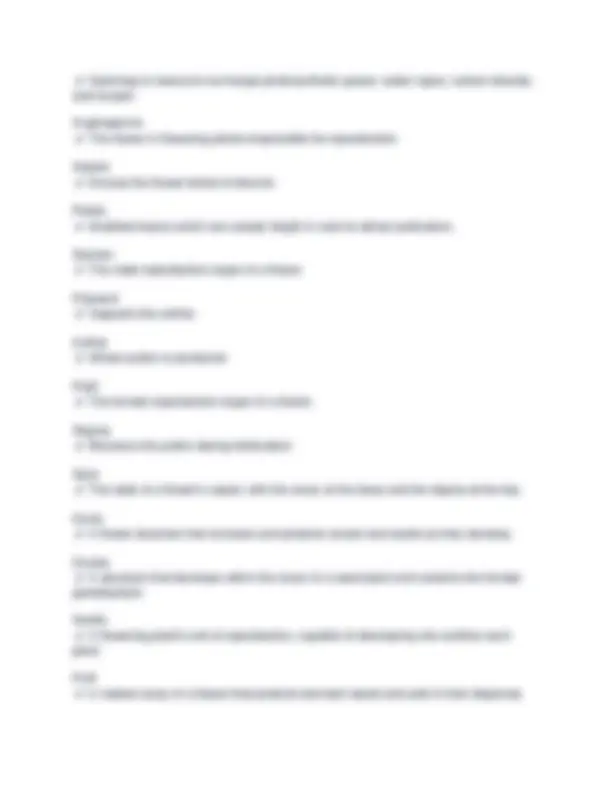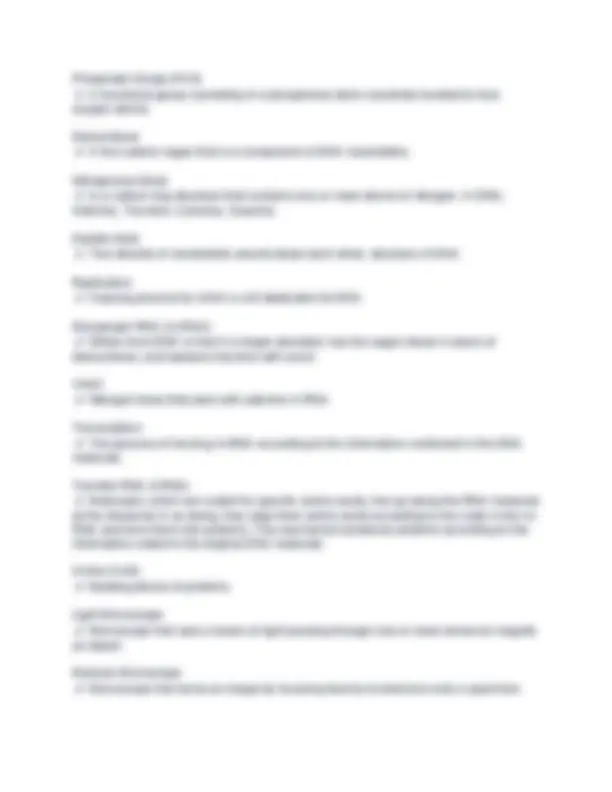








Study with the several resources on Docsity

Earn points by helping other students or get them with a premium plan


Prepare for your exams
Study with the several resources on Docsity

Earn points to download
Earn points by helping other students or get them with a premium plan
Community
Ask the community for help and clear up your study doubts
Discover the best universities in your country according to Docsity users
Free resources
Download our free guides on studying techniques, anxiety management strategies, and thesis advice from Docsity tutors
NEX Review - General Biology Questions with Answers latest 2025
Typology: Exams
1 / 11

This page cannot be seen from the preview
Don't miss anything!







Cell ✔ Smallest unit of life. The basic unit of funtin and structure for all living things. Nucleus ✔ Control center of the cell. Contains DNA. Contains genetic information. DNA (deoxyribonucleic acid) ✔ A complex molecule containing the genetic information that makes up the chromosomes. Plasma (or cell) membrane ✔ Acts as a barrier (semipermeable membrane) between the inside and outside of the cell, materials enter or exit through it. Interstitial Fluid ✔ Liquid found between the cells of the body that provides much of the liquid environment of the body. Contains acids, sugars, fatty acids, hormones, neurotransmitters, and salts. Selectively permeable (semipermeable) ✔ A property of cell membranes that allows some substances to pass through, while others cannot. Cytoplasm ✔ The fluid matrix found between the plasma membrane and the nucleus that acts as scaffolding for the organelles. Organelles ✔ "Little organs," specialized units in the cell that perform certain functions. Mitochondria ✔ Powerhouse of the cell, organelle that is the site of ATP (energy) production. ATP (adenosine triphosphate) ✔ A chemical the cell uses to store and transfer energy within itself. Ribosomes ✔ Are the sites of protein synthesis in the cell.
Endoplasmic Reticulum (ER) ✔ Serves as a main transport within the cell and is made up of many channels. Rough ER serves to store and deliver proteins made by the attached ribosomes. Smooth ER is free ribosomes and is found in a variety of cells, and has various functions including storage of enzymes and minerals and the folding of proteins. Golgi complex ✔ Organelle that modifies, packages, and transports material out of the cell. Lysosomes ✔ An organelle containing digestive enzymes. Cell wall ✔ A rigid structure that surrounds the cell membrane and provides support to the cell. Chloroplast ✔ Contains chlorophyll for photosynthesis. Vacuoles ✔ Compartments in the cytoplasms that act as places for secretion, excretion, and storage. Chromatin ✔ Clusters of DNA, RNA, and proteins in the nucleus of a cell. Chromosomes ✔ A threadlike structure of nucleic acids and protein found in the nucleus of most living cells, carrying genetic information in the form of genes. Mitosis ✔ A type of cell division, useful in the growth and repair of our bodies. Zygote ✔ The cell created by the union of a sperm and egg (fertilized egg). Contains a full set of chromosomes, half from each parent. Meiosis ✔ Cell division that consists first of a doubling of chromosomes and the two subsequent divisions. The products are four daughter cells, each with half the normal number of chromosomes. Tissues ✔ Groups of cells with a common structure and function.
✔ Study of past and present distribution of organisms. Comparative Anatomy ✔ The study of similarities and differences in the anatomy of different species. Comparative Embryology ✔ The study of the similarities and differences in the embryos of different species. Molecular Biology ✔ The study of heredity at the molecular level. Taxonomy ✔ The scientific study of how living things are classified. Kingdoms ✔ Classifications of Living things. There are 5 classifications: Animal, plant, monera, protist, and fungi. Animal ✔ A living thing that is not a human being or plant. Plant ✔ Multicellular eukaryote that produces its own food through photosynthesis. Monera ✔ Bacteria. One celled organism with no distinct nucleus. Protist ✔ An organism that belongs to the kingdom Protista. (Protozoa, algae, and some molds.) Fungi ✔ Kingdom composed of heterotrophs; many obtain energy and nutrients from dead organic matter. (molds, mushrooms, yeasts.) Phylum ✔ Group of closely related classes. Class ✔ Group of similar orders. Family ✔ Group of genera that share many characteristics.
Genus ✔ A classification grouping that consists of a number of similar, closely related species. Species ✔ A group of similar organisms that can breed and produce fertile offspring. Active Transport ✔ The movement of materials through a cell membrane using energy (ATP). Passive Transport ✔ Does not require energy and makes use of diffusion and filtration. Diffusion ✔ Movement of molecules from an area of higher concentration to an area of lower concentration. Osmosis ✔ Diffusion of water through a selectively permeable membrane. Isotonic ✔ When the solute concentration of the water is the same as that inside of the cell. Hypertonic ✔ When the solute is more concentration outside the cell than that inside of the cell. Hypotonic ✔ When the solute concentration outside the cell is lower than that inside the cell. Filtration ✔ the movement of water and solutes through the membrane by fluid, or hydrostatic, pressure. Autotroph ✔ Organisms that produce their own food from inorganic substances. Ex) Plants Heterotrophs ✔ Organisms that obtain their food by consuming plants or other animals. Primary Consumers ✔ Herbivores (plant eaters) or Omnivores (plant and meat eaters.)
✔ A relationship between two organisms in which one organism benefits and the other is unaffected. Mutualism ✔ A relationship between two species in which both species benefit. Biosphere ✔ Consists of all life on Earth and all parts of the Earth in which life exists, including land, water, and the atmosphere. Biomes ✔ A community of living organisms of a single major ecological region. Deserts ✔ A barren region with little or no rainfall, usually sandy and without trees. Tropical Rain Forests ✔ A woodland of tall trees growing in a region of year-round warmth and abundant rainfall. Deciduous Forest ✔ A forest biome with many kinds of trees that lose their leaves each autumn. Coniferous Forest ✔ A forest biome characterized by conifers, cone-bearing evergreen trees. These trees do not shed their leaves in cold, dry months. Tundras ✔ Are characterized by very cold temperatures and high altitude. Here the conditions allow shrubs and bushes to grow, but no trees. Photosynthesis ✔ Process by which plants and some other organisms use light energy to convert water and carbon dioxide into oxygen and high-energy carbohydrates such as sugars and starches. Chlorophyll ✔ Green pigment in plants that absorbs light energy used to carry out photosynthesis. Cuticle ✔ The waxy, waterproof layer that covers the leaves and stems of most plants. Stomates
✔ Openings in leaves to exchange photosynthetic gases: water vapor, carbon dioxide, and oxygen. Angiosperms ✔ The flower in flowering plants responsible for reproduction. Sepals ✔ Encase the flower before it blooms. Petals ✔ Modified leaves which are usually bright in color to attract pollinators. Stamen ✔ The male reproductive organ of a flower. Filament ✔ Supports the anther. Anther ✔ Where pollen is produced. Pistil ✔ The female reproductive organ of a flower. Stigma ✔ Receives the pollen during fertilization. Style ✔ The stalk of a flower's carpel, with the ovary at the base and the stigma at the top. Ovary ✔ A flower structure that encloses and protects ovules and seeds as they develop. Ovules ✔ A structure that develops within the ovary of a seed plant and contains the female gametophyte. Seeds ✔ A flowering plant's unit of reproduction, capable of developing into another such plant. Fruit ✔ A mature ovary of a flower that protects dormant seeds and aids in their dispersal.
Phosphate Group (PO4) ✔ A functional group consisting of a phosphorus atom covalently bonded to four oxygen atoms. Deoxyribose ✔ A five-carbon sugar that is a component of DNA nucleotides. Nitrogenous Base ✔ is a carbon ring structure that contains one or more atoms of nitrogen. In DNA, Adenine, Thymine, Cytosine, Guanine. Double Helix ✔ Two strands of nucleotides wound about each other; structure of DNA. Replication ✔ Copying process by which a cell duplicates its DNA. Messenger RNA (m-RNA) ✔ Differs from DNA in that it is single stranded, has the sugar ribose in place of deoxyribose, and replaces thymine with uracil. Uracil ✔ Nitrogen base that pairs with adenine in RNA. Transcription ✔ The process of forming m-RNA according to the information contained in the DNA molecule. Transfer RNA (t-RNA) ✔ Molecules, which are coded for specific amino acids, line up along the RNA molecule at the ribosome In so doing, they align their amino acids according to the code in the m- RNA and form them into proteins. This mechanism produces proteins according to the information coded in the original DNA molecule. Amino Acids ✔ Building blocks of proteins. Light Microscope ✔ Microscope that uses a beam of light passing through one or more lenses to magnify an object. Electron Microscope ✔ Microscope that forms an image by focusing beams of electrons onto a specimen.
Compound Microscope ✔ A light microscope that has more than one lens. Data ✔ Facts, figures, and other evidence gathered through observations. Variables ✔ Any measurable conditions, events, characteristics, or behaviors that are controlled or observed in a study. Independent Variable ✔ The experimental factor that is manipulated; the variable whose effect is being studied. Dependent Variable ✔ The outcome factor; the variable that may change in response to manipulations of the independent variable. Constants ✔ Conditions that stay the same in the experiment. Controlled Experiment ✔ An experiment in which only one variable is manipulated at a time.